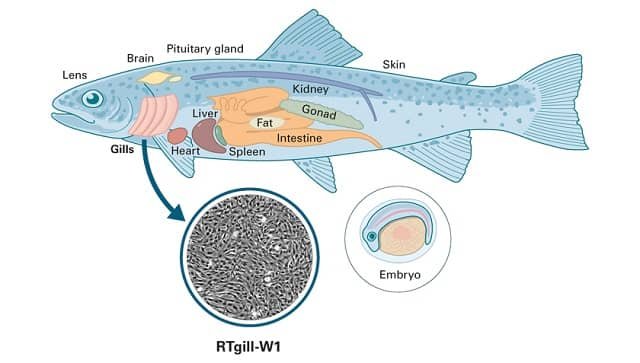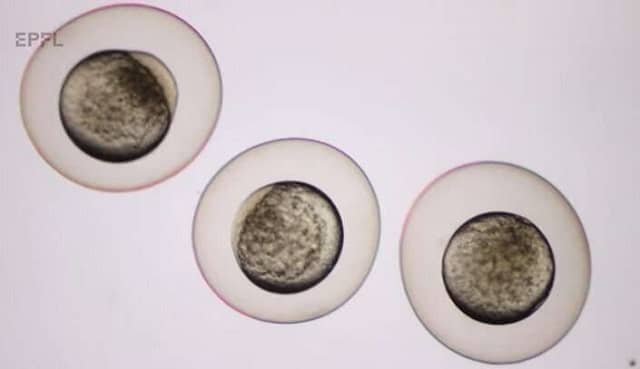by Sandrine Perroud, Ecole Polytechnique Federale de Lausanne (EPFL)
When fish ingest microplastics, they often also ingest progesterone. This compound is subsequently released into the digestive tract through chemical reactions with the fish’s digestive fluids. That’s the key finding of a study carried out jointly by scientists from EPFL, the Swiss Federal Institute of Aquatic Science and Technology (Eawag), Peking University in Beijing, and Oklahoma State University, and appearing in Environmental Science: Processes & Impacts.
“Our study shows that microplastics are an additional vector for exposing fish to micropollutants like progesterone, a steroid hormone that can be found in the environment,” says Florian Breider, the head of EPFL’s Central Environmental Laboratory and a co-author of the study. “These microplastics act like sponges and serve as a vector – they readily absorb hydrophobic micropollutants in water, since the pollutants’ molecules would rather attach to the plastic,” says Breider. “Once inside a fish, the molecules are released into its digestive tract as a result of the physical and chemical properties of the digestive fluids. Today, nobody knows whether the micropollutants subsequently pass through the intestinal walls and spread to the rest of the fish.”
Three kinds of polymers
The study looked at microplastics made of three kinds of polymers: polyethylene, polypropylene and polystyrene. These types of microplastics are widely found in Swiss rivers and lakes. The scientists examined the polymers’ adsorption capacity, or how well they attract and bind to micropollutants like progesterone, and their desorption capacity, or how quickly and easily they can release micropollutants into a fish’s digestive tract. This enabled them to determine how the progesterone molecules behave across the entire cycle.
Several studies have already been carried out on highly hydrophobic micropollutants such as polychlorinated biphenyls (PCBs). But in this study, the scientists found that progesterone – which is much less hydrophobic – behaves the same way in the presence of microplastics. What’s more, progesterone is released into digestive fluids to a greater extent. This indicates that the ingestion of microplastics could play a significant role in exposing aquatic organisms to progesterone, an endocrine disrupter. The scientists estimate that “if an organism weighing one kilogram ingests 4.5 liters of water per day, this vector of progesterone exposure – that is, through microplastics – would account for 10% of its daily progesterone intake due to water ingestion,” says Breider.
Few studies conducted in Switzerland
More research needs to be done on how micropollutants carried by microplastics affect aquatic ecosystems and ultimately human beings. Few studies have been carried out so far, especially on freshwater organisms in Switzerland. That’s probably due to the country’s landlocked geography. “In countries bordering a sea or ocean, research on plastic contamination and the associated micropollutants is becoming a priority. But that’s not the case in Switzerland,” says Breider. “However, people are becoming increasingly aware of the issue and eager to take action. Things are moving in the right direction.”
Reference:
Cécilia Siri, Yang Liu, Thibault Masset, William Dudefoi, Dean Oldham, Matteo Minghetti, Dominique Grandjean and Florian Breider, “Adsorption of progesterone onto microplastics and its desorption in simulated gastric and intestinal fluids”, Environmental Science Processes & Impacts, 13 September2021.DOI: 10.1039/d1em00226k
Editor at the digital magazine AquaHoy. He holds a degree in Aquaculture Biology from the National University of Santa (UNS) and a Master’s degree in Science and Innovation Management from the Polytechnic University of Valencia, with postgraduate diplomas in Business Innovation and Innovation Management. He possesses extensive experience in the aquaculture and fisheries sector, having led the Fisheries Innovation Unit of the National Program for Innovation in Fisheries and Aquaculture (PNIPA). He has served as a senior consultant in technology watch, an innovation project formulator and advisor, and a lecturer at UNS. He is a member of the Peruvian College of Biologists and was recognized by the World Aquaculture Society (WAS) in 2016 for his contribution to aquaculture.
Stay Always Informed
Join our communities to instantly receive the most important news, reports, and analysis from the aquaculture industry.




